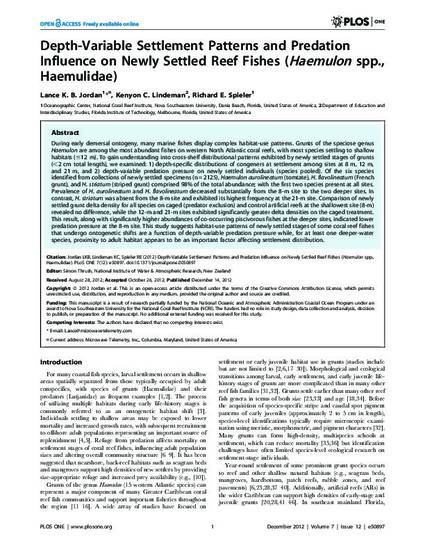
- Analysis of variance,
- Coral reefs,
- Death rates,
- Fishes,
- Habitats,
- Neostriatum,
- Predation,
- Reefs
During early demersal ontogeny, many marine fishes display complex habitat-use patterns. Grunts of the speciose genus Haemulon are among the most abundant fishes on western North Atlantic coral reefs, with most species settling to shallow habitats (≤12 m). To gain understanding into cross-shelf distributional patterns exhibited by newly settled stages of grunts (<2 cm total length), we examined: 1) depth-specific distributions of congeners at settlement among sites at 8 m, 12 m, and 21 m, and 2) depth-variable predation pressure on newly settled individuals (species pooled). Of the six species identified from collections of newly settled specimens (n = 2125), Haemulon aurolineatum (tomtate), H. flavolineatum(French grunt), and H. striatum (striped grunt) comprised 98% of the total abundance; with the first two species present at all sites. Prevalence of H. aurolineatum and H. flavolineatumdecreased substantially from the 8-m site to the two deeper sites. In contrast, H. striatum was absent from the 8-m site and exhibited its highest frequency at the 21-m site. Comparison of newly settled grunt delta density for all species on caged (predator exclusion) and control artificial reefs at the shallowest site (8-m) revealed no difference, while the 12-m and 21-m sites exhibited significantly greater delta densities on the caged treatment. This result, along with significantly higher abundances of co-occurring piscivorous fishes at the deeper sites, indicated lower predation pressure at the 8-m site. This study suggests habitat-use patterns of newly settled stages of some coral reef fishes that undergo ontogenetic shifts are a function of depth-variable predation pressure while, for at least one deeper-water species, proximity to adult habitat appears to be an important factor affecting settlement distribution.
Available at: http://works.bepress.com/richard-spieler/38/

©2012 Jordan et al. This is an open-access article distributed under the terms of the Creative Commons Attribution License, which permits unrestricted use, distribution, and reproduction in any medium, provided the original author and source are credited.